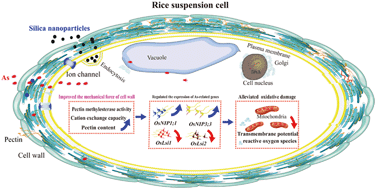Silica nanoparticles inhibit arsenic uptake into rice suspension cells via improving pectin synthesis and the mechanical force of the cell wall†
Abstract
Our previous studies indicated that the foliar application of silica nanoparticles (SiO2 NPs) could obviously reduce arsenic (As) accumulation in rice. However, the mechanism underlying this effect at the single-cell level has not been reported. In this study, we investigated for the first time the effects of SiO2 NPs on inhibiting As uptake into rice using individual rice cells. The results indicated that the addition of SiO2 NPs could enhance the proportion of live cells by weakening oxidative stress upon As exposure. Compared to the treatment of cells with As only, treatment with SiO2 NPs could maintain the integrity of the cell, increase the thickness of the cell wall (77.4%) and the ratio of As in the pectin (19.6%). In addition, the pectin content, cation exchange capacity (CEC) and pectin methylesterase (PME) activity were also increased in the SiO2 NPs-pretreated cells, leading to a decreased degree of pectin methylesterification and an improved mechanical force of the cell walls. Furthermore, in the SiO2 NPs-pretreated rice cells, the expression of the OsLis1 and OsLis2 genes was lower, whereas the expression of the OsNIP1;1 and OsNIP3;3 genes was higher than that of the As-only group. This finding provides new insights into the mechanism of how the addition of SiO2 NPs inhibits As uptake into rice at the single-cell level and lays the foundation for its application in As-contaminated paddy soil.



 Please wait while we load your content...
Please wait while we load your content...